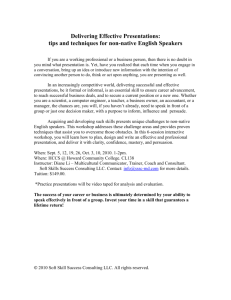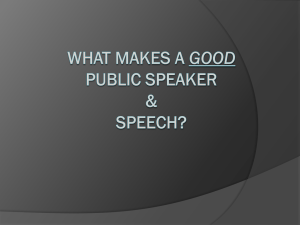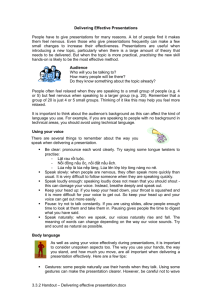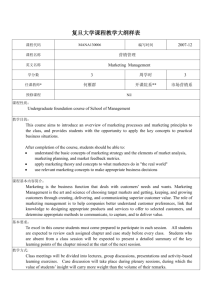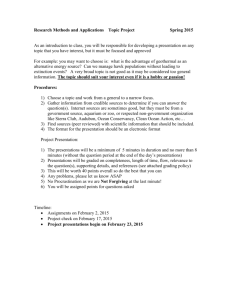Prepare, Practice, Present Delivering Effective Presentations
advertisement
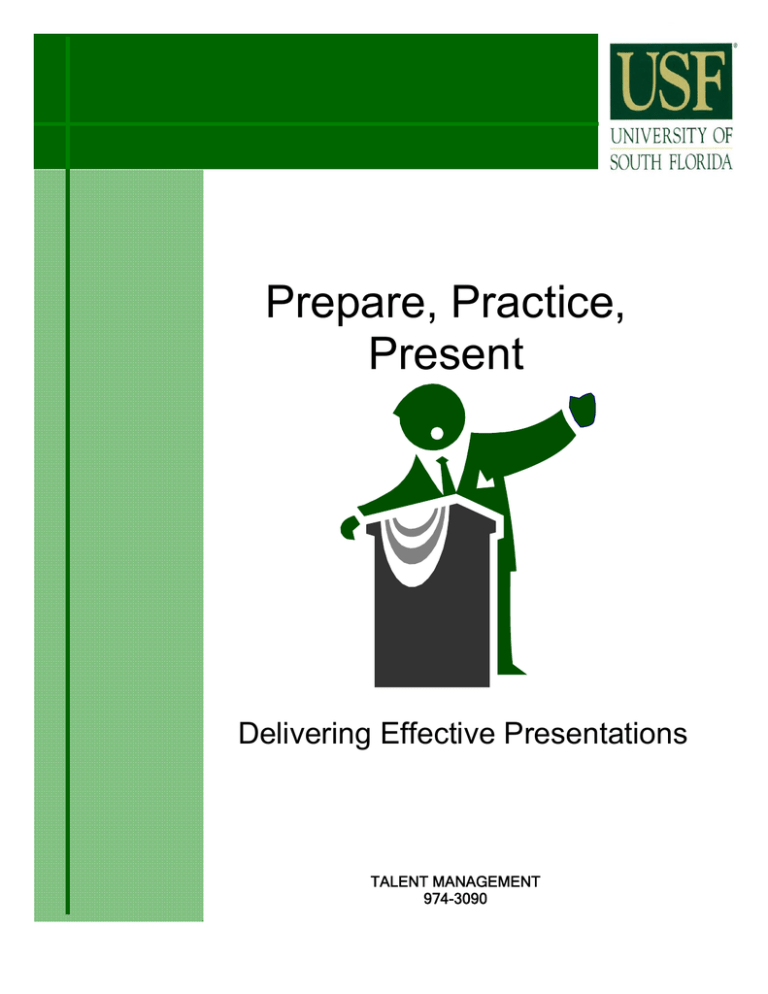
Delivering Effective Presentations Prepare, Practice, Present Delivering Effective Presentations TALENT MANAGEMENT 974-3090 Delivering Effective Presentations Course Objectives By the end of this workshop, participants will be able to: • • • • • • • Describe best practices associated with the verbal and non-verbal delivery of presentations Demonstrate effective posture, gestures, eye-contact, volume, and vocal variety when delivering a presentation Write a clear statement of purpose Organize the main ideas of your presentation in a logical structure Create the outline of a presentation opening and closing List best practices when inviting and responding to audience questions Describe recommended guidelines to follow when using presentation software (e.g. Power Point) Delivering Effective Presentations The Effective Presenter Outlined below are two categories of skills and behaviors used by effective presenters. Effective Delivery Techniques 1. Professional appearance 2. Pleasant and varied voice 3. Positive body language 4. Excellent eye contact 5. Effective gestures and movement Effective Preparation & Content Organization 1. Objectives clearly stated 2. Strong opening and close 3. Well organized 4. Correct level of detail 5. Effective visual aids 2 Delivering Effective Presentations Developing Your Voice When you deliver a presentation, your audience not only hears what you say, they also observe how you say it. Your presentation is both visible and audible. What kind of voice do you have? 1. Is it monotonous? A flat voice with little to no inflection can lead audience members to lose interest. 2. Is it harsh? An overly loud, harsh vocal quality can be jarring for participants 3. Unfriendly? A cold, distant or aloof sounding voice can come across as indifference toward the topic and/or audience 4. Is it too fast or too slow? Speaking at a constant rate that is either too fast or too slow can result in losing the audience’s attention. Vary your rate of speech at key moments to add emphasis or re-capture the audience’s attention. 5. Do you talk too quietly? Too loudly? Speech at a constant volume can also be distracting. Find a volume that is easy for those at the back of the room to hear, and then vary your volume at key moments to add emphasis. 6. Do you have an expressive voice? Lack of variation and expression can feel too mechanical for audience members. Speak as though you’re telling a story or having a conversation with a trusted friend. 7. Do you control the pitch? Shift pitch to add emphasis and expression Best Practices! Vary the tone, rate & volume of speech Talk to your audience at their level - not above or below Project beyond the back wall Put energy and animation in your voice Be yourself 3 Delivering Effective Presentations Eye Contact What the face and eyes say is tremendously important for communication. This is a way for you to say to everyone in the audience, “You are important. I’m talking just to you.” 1. As you talk to people, look them in the eyes. It’s important to note that the meaning of eye contact varies across cultures. In general, this culture views eye contact as a sign of respect, confidence, and consideration. It is equated with openness & honesty. 2. Eye contact is one of the ways to keep people listening. It is also a source of feedback from the audience. 3. When using notes or visual aids, keep eye contact with the audience. 4. Be sensitive to the proper duration of eye contact. Too much directed at one or two people can feel overly intense or intimate. 5. Look at people directly and talk to everybody. 6. Watch the tendency to ping-pong back and forth to the same people. Adopt a random pattern. 7. Don’t look at the same two or three people, or stare over the heads of the audience. 8. Be careful of a visual obsession with one side of the room to the exclusion of the other. Best Practices! Be careful with duration (about 3 seconds) Don’t ping-pong back and forth between 2 people Avoid the tendency to stare at the ground or over heads Evenly distribute eye contact Try not to favor a few people or one side of the room 4 Delivering Effective Presentations Gestures “What do I do with my hands?” is a common question. They often are the source of much trouble and amusement, as presenters desperately try to get them out of the way, or use them to make gestures that often fail to match the words they’re supposed to emphasize. A presenter who can use his or her hands well adds a powerful complement to his or her language and vocal expression. Best Practices! Adopt a hand position that isn’t distracting for the audience 9 Recommendation: hands resting in front of you between waist & shoulders (e.g. steeple) Keep gestures simple and varied Avoid overuse of gestures Don’t grip unmovable objects Avoid the following: 9 crossing your arm 9 fidgeting 9 hands behind back 9 fig leaf 9 hands in pockets 9 playing with pen or other object 5 Delivering Effective Presentations Posture and Movement The message imparted by what the presenter’s body does is an early and important one. Audience members make an instant judgment of a speaker’s competence, character, confidence, and openness by their first views of the speaker. The beginning of the presentation offers an opportunity to start sending positive nonverbal messages. 1. Watch your nonverbal behavior while you’re waiting to present. Walk comfortably and confidently to the proper place in the room. 2. Adopt a comfortable stance, with weight evenly balanced on both feet. Directly face the audience and stand as close to them as makes sense. 3. Be sensitive to your posture and movement throughout the presentation. Don’t get cemented in one place. 4. Remove barriers between you and your audience – distance is a barrier. 6. Purposeful movement can add to the impression of assurance. It may also help dispute nervous energy and keep you relaxed. 7. Adopt a posture that is natural for you, not forced for the occasion. A forward-leaning stance is often viewed as challenging. Arms crossed may be viewed in a negative, threatening manner. A side slouch, with weight on one leg and possibly an arm on the hip, may be regarded as sloppy or overly casual. Best Practices! Walk with confident strides Adopt a comfortable stance Evenly distribute your weight Keep as few barriers as possible between you and the audience Avoid being cemented in one place 6 Delivering Effective Presentations Putting It All Together Voice Vary the tone and rate of your speech Talk to your audience at their level - not above or below Project beyond the back wall Put energy and animation in your voice Be yourself Eye Contact Be careful with duration (about 3 seconds) Don’t ping-pong back and forth between 2 people Avoid the tendency to stare at the ground or over heads Evenly distribute eye contact o Try not to favor a few people or one side of the room Gestures Adopt a hand position that isn’t distracting for the audience o Recommendation: hands resting in front of you between waist & shoulders (e.g. steeple) Keep gestures simple and varied Avoid overuse of gestures Don’t grip unmovable objects Avoid the following: o crossing your arm o fidgeting o hands behind back o fig leaf o hands in pockets o playing with pen or other object Posture & Movement Walk with confident strides Adopt a comfortable stance Evenly distribute your weight Keep as few barriers as possible between you and the audience Avoid being cemented in one place 7 Delivering Effective Presentations Skill Practice You will work in groups of three to four people. The person practicing the skill is to stand in front of their group and respond to one of the questions listed above (or an alternative one of their choosing). Each speaker speak for 2-3 minutes. The remaining people in the group are to act as audience members and coaches. They will observe the person practicing the skills. After each speaker finishes, have the group provide feedback before moving onto the next speaker. Skill Practice Question Options: 1. What drew you to choose the career you’re in? (What energizes you about this line of work?) 2. Describe a personal or professional goal of yours and the steps you plan to take to achieve it. 3. If you could change anything in this organization, what would it be? Use the space below to jot down the key points you’d like to make: _________________________________________________________________ _________________________________________________________________ _________________________________________________________________ _________________________________________________________________ _________________________________________________________________ _________________________________________________________________ _________________________________________________________________ 8 Delivering Effective Presentations Coaching & Giving Feedback 1. Tell the person practicing what you believe he or she did well. Say this first so you don’t forget. Be specific. For example, if you like the fact that the person practicing inflected his or her voice on key words, say so. Don’t assume anything. There is nothing too mundane or trite in coaching a skill practice. Everything helps. 2. Tell the person practicing what could use improvement. Think about what might make the practice session better from your perspective. Give the person practicing your suggestions. The time to experiment and make mistakes is in practice, not on the job. So don’t be afraid to give your honest insights. Be clear and specific. Be both honest and empathetic. Don’t comment on things the person cannot change. 9 Delivering Effective Presentations Skill Practice Coaching Checklist Notice and provide feedback on the following: Rate of speech o Is it too fast? o Is it too slow? Energy and animation o Are these present in the speaker’s voice? o Does his or her voice sound monotone at points? Confidence o Does the person seem comfortable and relaxed? o Does the person present him or herself confidently? Rapport o Did you feel comfortable and at ease as the person was speaking? o Did you feel involved – like he or she was speaking to you? Volume o Is it too loud? o Is it too soft? Clarity o Did you easily understand the points being made? o Did the speaker ramble or lose focus? Time o Did the speaker take too much time to make his or her points? o Did the speaker take too little time to make his or her points? What else went well? What else could be improved? 10 Delivering Effective Presentations Administration One of the most overlooked roles of a presenter is the administrative role. Too often, the entire focus is on the presentation, and very little time or thought is given to the logistics, preparation, or organization of the presentation. Below are some of the administrative tasks to attend to prior to a presentation. Use the spaces provided below to write your additional suggestions. 1. Arrange breaks and start/stop times. 2. Keep the presentation on schedule. 3. Distribute necessary material. 4. Test technology and plan contingencies 5. Arrange the room in a way that is conducive to the dynamics you want to create in the room 11 Delivering Effective Presentations Preparing Presentations The presentation you design should be hard hitting and presented in a logical flow for the audience. The way to achieve this goal is to focus on the three key components listed below. Below each component are targeted questions to ask while you are creating your presentation. OPENING Capture their attention State your purpose, objective/s State your main thesis Show how the topic impacts what they care about (Why should they listen?) Demonstrate credibility (Why should they listen to you?) Give a preview of the points you will cover (Tell them what you plan to tell them) Transition Statement BODY Select an effective organizational pattern Provide support for each of your main points (vary the type of support material you use) Plan transition statements between points Ensure that each point builds upon the last, leads toward the next, and supports your primary purpose/objectives Plan ways to recapture the audience’s attention If seeking to influence or persuade, ensure that your arguments are sound Transition Statement CLOSING Summarize the points you discussed (Tell them what you told them) Restate your main thesis Let them know where to go from here (what you’re hoping they will know, believe, consider, feel, or do) End with an impact (clincher) 12 Delivering Effective Presentations Define Your Purpose Outlined below are some helpful hints for defining your objectives: 1. The objective answers the question, “Why am I doing this presentation?” 2. The audience should feel the presentation was designed for them. 3. When possible, gather information about the audience ahead of time. What age groups will be represented? They may have different objectives. Are they technical information or general information oriented? They want different levels of detail. What is their role in the organization? They have different interests. What is their current level of understanding and familiarity with the subject you’ll be discussing? You’ll want to avoid patronizing them or talking over their heads. 4. When it’s all over, what is it you want the audience to remember, understand, believe, or do as a result of hearing what you have to say? Define Your Purpose Exercise 1. Select a relevant personal or business topic, preferably one that you have presented on in the past or will be presenting on in the future. A) Write the objective/s for your presentation below. ______________________________________________________________ ______________________________________________________________ ______________________________________________________________ ______________________________________________________________ 13 Delivering Effective Presentations Create Your Opening 1. Capture the audience’s attention and interest Startling statistic Quote Story Visualization: Picture this… Rhetorical question 2. State your purpose 3. Tailor the opening to the audience (Show how the topic is relevant) Learn as much as possible about the audience in advance. If there are introductions, you might pick up additional information. Be flexible enough to make any minor modifications in your opening based on last minute observations and information. During your opening, clearly state how the topic is relevant to audience members based on what you’ve learned about them 4. Demonstrate credibility Clearly state your experience and background related to the topic you’ll be discussing 5. Preview your main points Clearly state your experience and background related to the topic you’ll be discussing 14 Delivering Effective Presentations Create Your Opening Exercise Develop an opening statement based on your subject and objectives. This is a good opportunity to brainstorm several different openings. Use the spaces below to write your statements. _________________________________________________________________ _________________________________________________________________ _________________________________________________________________ _________________________________________________________________ _________________________________________________________________ _________________________________________________________________ _________________________________________________________________ _________________________________________________________________ _________________________________________________________________ _________________________________________________________________ _________________________________________________________________ _________________________________________________________________ . 15 Delivering Effective Presentations Design the Body of Your Presentation The body needs to support your opening statements, provide compelling information that illustrates your key ideas, and prepare the audience for your closing statements. Outlined below are several key points to consider. 1. Decide on organizational pattern for your key points Chronological Features/ Benefits Topical Old Way/ New Way Categorical Advantages/Disadvantages Problem/ Cause/ Goal/ Roadmap Solution Comparison/ Contrast Objections/ Answers Ideal vs. Reality Added Value 2. Decide on Visual Aids Go through each of the pages or cards and decided whether a visual aid would help explain, understand, or punctuate the thought. If yes, what picture, symbol, or graphic would be best? 3. Add Interest Breathe life and human interest into the presentation by adding: Stories Examples Analogies Activities Jokes Questions Current events Statistics Quotes Testimonials 16 Delivering Effective Presentations 4. Create Notes Decide on the first three to five words you will use to introduce each key point. Next, develop any essential words or phrases for the details on each key point. Write out any special instructions to yourself such as when to use handouts, the flip chart, pointer, etc. 5. Plan your transitions! This is where presenters often fumble. Be sure to plan out how you will transition from one main point to the next. It can be helpful to write these out on note cards that you can refer to during your delivery. 17 Delivering Effective Presentations Design the Close You want the objective and the close to dictate the content of the entire presentation. From the audience’s point of view, it is the close where they hear what they came to hear. Everything up to that point has been in support of the close. What is it you want them to have in their heads when they leave? Outlined below are elements that should be included in the close of your presentation: • Indicate that you’re coming toward the end of the presentation • Clearly restate your objective and how you’ve accomplished this • Provide a summary of the main points you’ve discussed • End with an impact! Leave a positive and memorable impression. Examples include ending with a story, quote, or compelling statistic. Design the Close Exercise Use the spaces below to write your closing statements. Be creative in your close. Use any of the previous examples or develop one of your own. Remember to answer the question, “What is it you want them to have in their heads when they leave?” Again, the more thought-provoking or stimulating you are, the more likely the audience will listen to you and achieve your objective. _________________________________________________________________ _________________________________________________________________ _________________________________________________________________ _________________________________________________________________ _________________________________________________________________ **Practice your closing several times so you know it flows smoothly from the body and does what you designed it to do. 18 Delivering Effective Presentations Handling Questions The questions you get and the way you answer them are a reflection of your skill as a presenter. Here are some techniques: • Listen to all of the question. Even though the first few words may tell you what the question is, let the person finish. Don't be impatient. • Show that you are listening. Do not fumble with notes or multi-task while the person is talking. Look directly at the person. • Show an interest. Remarks such as "That's a good question" compliment participants for being alert. • Repeat the question to the whole group. This not only permits the entire group to hear the question but also gives the individual a chance to confirm the question. It also gives you time to think. • Answer the question carefully. Take your time and be sure to cover all aspects of the question. • Be willing to say “I don’t know.” Offer to find accurate information related to the inquiry and pass that on to the questioner. • Check the answer. Ask, "Does that answer your question?" 19 Delivering Effective Presentations Using Power Point Power Point can add value to a presentation or distract from the message to the presentation, depending on how it’s used. Following the general guidelines listed below can help you to avoid the common misuses of the Power Point tool. Use power point as a support, not the main focus 3 Slides should contain short points that remind you what you want to cover and help the audience follow the flow of the presentation 3 They should not contain a full text script of what you plan to say If the presenter is not adding to the information written on the slides, he or she isn’t really necessary If you want interaction, don’t turn off lights Don’t read the presentation Use PPT to trigger thoughts General Slide Design Guidelines: Use dark text on a light background or light text on a dark background No more than 7 words per line No more than 7 lines per slide Limit graphics to 1-2 per slide Don’t mix drawings and photographs Use animation sparingly (animation = bringing in bulleted phrases one at a time, rather than all at once) 3 Although animation can be helpful in moderation, it is often more of a distraction to the audience rather than an added benefit. Don’t be the person that spends more time on jazzy animation than on the organization and quality of the presentation content. 20
